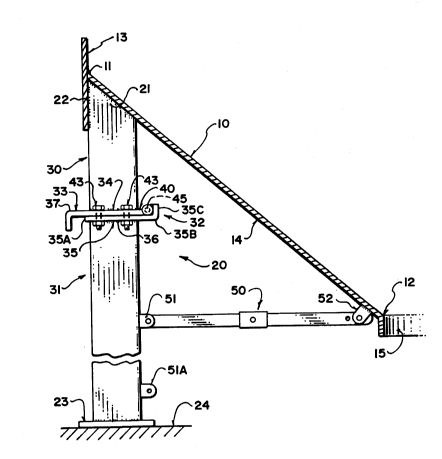Une partie des informations de ce site Web a été fournie par des sources externes. Le gouvernement du Canada n'assume aucune responsabilité concernant la précision, l'actualité ou la fiabilité des informations fournies par les sources externes. Les utilisateurs qui désirent employer cette information devraient consulter directement la source des informations. Le contenu fourni par les sources externes n'est pas assujetti aux exigences sur les langues officielles, la protection des renseignements personnels et l'accessibilité.
L'apparition de différences dans le texte et l'image des Revendications et de l'Abrégé dépend du moment auquel le document est publié. Les textes des Revendications et de l'Abrégé sont affichés :
| (12) Brevet: | (11) CA 2189476 |
|---|---|
| (54) Titre français: | TREMIE GERBABLE POUR RECIPIENT DE STOCKAGE |
| (54) Titre anglais: | STACKABLE HOPPER BOTTOM FOR STORAGE BIN |
| Statut: | Réputé périmé |
| (51) Classification internationale des brevets (CIB): |
|
|---|---|
| (72) Inventeurs : |
|
| (73) Titulaires : |
|
| (71) Demandeurs : |
|
| (74) Agent: | ADE & COMPANY |
| (74) Co-agent: | |
| (45) Délivré: | 1997-07-22 |
| (22) Date de dépôt: | 1996-11-04 |
| (41) Mise à la disponibilité du public: | 1996-12-04 |
| Requête d'examen: | 1996-11-04 |
| Licence disponible: | S.O. |
| (25) Langue des documents déposés: | Anglais |
| Traité de coopération en matière de brevets (PCT): | Non |
|---|
| (30) Données de priorité de la demande: | S.O. |
|---|
Fond à trémie servant à supporter une cellule à grain et comportant une paroi de trémie tronconique et une goulotte d'évacuation montée sur une base centrale. Plusieurs bras verticaux, disposés sur le pourtour de la paroi, supportent cette dernière au-dessus d'une surface de soutien horizontale. Les bras sont constitués de tubes de section carrée munis d'une charnière qui délimite, à la partie supérieure, un tronçon fixe et, à la partie inférieure, un portion principale pivotante. La charnière est installée à l'intérieur de la face interne du bras, de sorte que la portion principale puisse être repliée vers l'intérieur et vers le bas. Elle est également munie d'une paire de plaques, l'une étant soudée à l'extrémité supérieure de la portion principale et l'autre à l'extrémité inférieure du tronçon de bras. Cette dernière se prolonge vers l'extérieur du bras et porte à son bout le plus éloigné une bride renversée de sorte que le rebord supérieur du fond à trémie inférieur puisse s'accrocher sur le revers de la portion faisant saillie vers l'extérieur. Les bras peuvent ainsi être repliés vers l'intérieur et demeurer fixés au fond à trémie pendant le transport.
A hopper bottom for supporting a grain bin includes a frustro
conical hopper bottom wall with a discharge opening at a central base.
Around the periphery of the wall is provided a plurality of vertical legs which
support the wall above a horizontal support surface. The legs are formed
square tubing with a hinge part way along the leg so as to divide the leg
into an upper fixed stub portion and a lower pivotal main portion. The hinge
is positioned inside the inside surface of the leg so that the main portion can
fold to a position extending inwardly and downwardly. The hinge includes a
pair of plates welded to the upper and lower ends of the main and stub
portions. The plate at the bottom of the stub portion extends outwardly
from the leg with a downturn flange at its outermost end so that the upper
edge of the lower hopper bottom can engage against the underside of the
outwardly projecting portion allowing the hopper bottom to be stacked for
transportation while the legs remain attached to the hopper bottom but
folded inwardly.
Note : Les revendications sont présentées dans la langue officielle dans laquelle elles ont été soumises.
Note : Les descriptions sont présentées dans la langue officielle dans laquelle elles ont été soumises.

Pour une meilleure compréhension de l'état de la demande ou brevet qui figure sur cette page, la rubrique Mise en garde , et les descriptions de Brevet , États administratifs , Taxes périodiques et Historique des paiements devraient être consultées.
| Titre | Date |
|---|---|
| Date de délivrance prévu | 1997-07-22 |
| (22) Dépôt | 1996-11-04 |
| Requête d'examen | 1996-11-04 |
| (41) Mise à la disponibilité du public | 1996-12-04 |
| (45) Délivré | 1997-07-22 |
| Réputé périmé | 2000-11-06 |
Il n'y a pas d'historique d'abandonnement
| Type de taxes | Anniversaire | Échéance | Montant payé | Date payée |
|---|---|---|---|---|
| Le dépôt d'une demande de brevet | 0,00 $ | 1996-11-04 | ||
| Taxe de maintien en état - brevet - nouvelle loi | 2 | 1998-11-04 | 250,00 $ | 1998-12-09 |
Les titulaires actuels et antérieures au dossier sont affichés en ordre alphabétique.
| Titulaires actuels au dossier |
|---|
| EPP, RICHARD E. |
| EPP, DWAYNE S. |
| Titulaires antérieures au dossier |
|---|
| S.O. |
Sélectionner une soumission LSB et cliquer sur le bouton "Télécharger la LSB" pour télécharger le fichier.
Si vous avez des difficultés à accéder au contenu, veuillez communiquer avec le Centre de services à la clientèle au 1-866-997-1936, ou envoyer un courriel au Centre de service à la clientèle de l'OPIC.
Soyez avisé que les fichiers avec les extensions .pep et .seq qui ont été créés par l'OPIC comme fichier de travail peuvent être incomplets et ne doivent pas être considérés comme étant des communications officielles.
Aucun fichier LSB n'a été fourni.